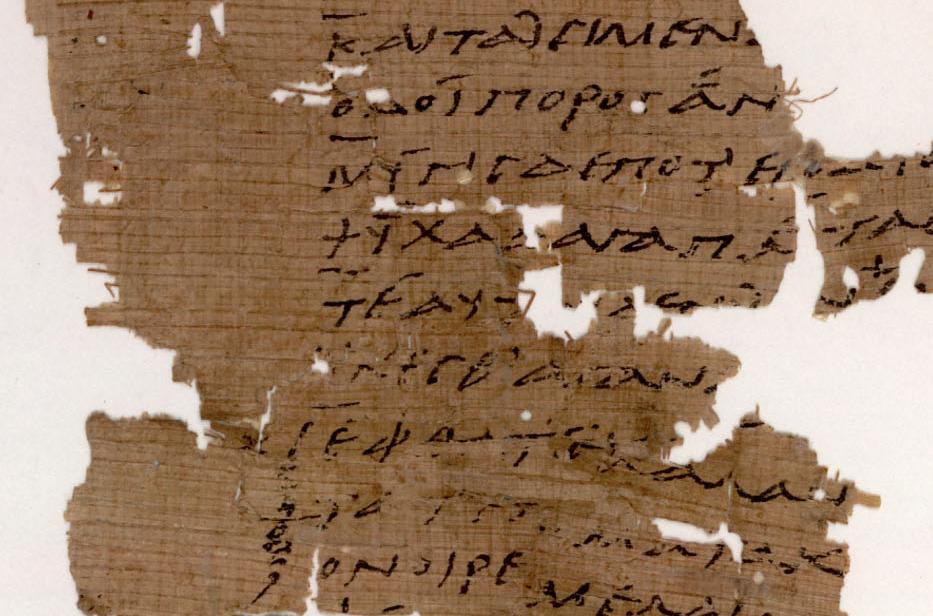Somewhat recently, I stumbled upon this Italian Sappho anthology, where, among other combinations, the following is found:
First off, they are not listing all the fragments joined into this combination. Besides LP 86, LP 60, and LP 65, there are also LP 66(c) and LP 67(a) in here. I tried to trace all I saw here, and mostly succeeded, except for ll. 12-13, which seem to have come from nowhere. I color-coded LP 60 black, LP 67(a) blue, LP 65 red, LP 66(c) green, the unidentified end-of-lines pink, and LP 86 purple, and, with minimal adjustments to the text (including reinstating a completely ignored line of 67(a) which gives the very beginning of l. 21 and fixing the inmetrical ἀμφιβιβάσκει in l. 27 to ἀμφιβάσκει, hopefully without altering the meaning too much - and the translation "circonda", "surrounds", makes me optimist since I know ἀμφιβάσκει means "surrounds" from an Edmonds restoration reading μυρίαν ἄμμω]ν ῤύτιν ἀμφιβάσκει), I got the following:
Note that the supplements are usually left black, unless they are somehow "called for" by a papyrus fragment, in which case they take the color of that fragment. Note also that this is a preview of a blog post due next Saturday, hence the green background. Finally, note that I introduced the notation of underlined letters for those letters that, in a raw transcription, would be simple "."s, but are guessed based on surrounding words/letters or on accent marks above them.
I have a couple guesses as to the origin of those pink letters:
- They come from lines in P.Halle 3 (source of the black part of my collage) which for some reason weren't included in the Lobel-Page text. Which would clearly beg the question: why did LP not include those lines? And why did this anthology do it? Then again, P.Halle 3 was republished as P.Oxy. 1787 fr. 44, and the volume of "The Oxyrhynchus Papyri" containing P.Oxy. 1787 (vol. XV) doesn't have those lines, so I guess we can exclude this.
- They come from another LP fragment, in which case they'd somehow have to come from LP 87(15), the only one from P.Oxy. 1787 vaguely matching those things. Which would beg the question: where is l. 1 of that fragment, and where are the vestige in «.ν» and the uncertain alpha in the following line come from, since LP didn't have them in the text of 87(15)?
- They come from another P.Oxy. 1787 fragment which was relocated among another author's works, e.g. one of the hundred-odd that Lobel decided were Pindar (cfr. this older question of mine). Which begs the questions: (a) Was it just two lines? (b) If so, why was it relocated? (c) If not, where is the rest of it in this joining? Looking at The Oxyrhynchus Papyri vol. XV, I realized 87(15) was not P.Oxy. 1787, but P.Oxy 2166(d), so those may have to be searched too. The Oxyrhynchus volume doesn't give any fragments that could be the source of those pink lines, and LP has all 2166(d) fragments from 1 to 13, so either it's 2166(d) fr. 5 (aka LP 87(15)), or it's a 2166(d) fragment with number not between 1 and 13, or I'm missing something.
- They come from a very recent fragment I have never heard about, found after Lobel-Page. Which obviously makes me curious to know more about it.
Can you help me trace those to their source?
UPDATE
Una Mitra per Cleis, where Ferrari published the fusion's text (or almost - cfr. this other question and my answer there), has those line endings just pop up out of nowhere, as if they were from one of the fragments joined into this. So the mystery thickens.





